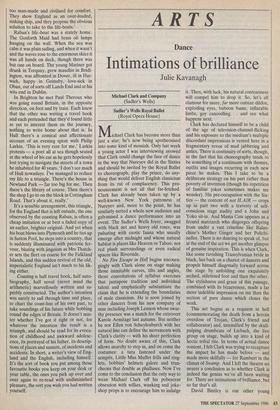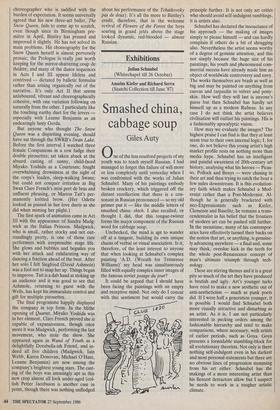ARTS
Dance
Intimations of brilliance
Julie Kavanagh
Michael Clark has become more than just a star; he's now being apotheosised into some kind of messiah. Only last week a young actor I was interviewing avowed that Clark could change the face of dance in the way that Nureyev did in the Sixties and should be invited by the Royal Ballet to choreograph, play the prince, do any- thing that would deliver English classicism from its rut of complacency. This pro- nouncement is not all that far-fetched. Clark has already been taken up by a well-known New York patroness of Nureyev and, more to the point, he has similarly netted a whole new audience and galvanised a dance performance into an event. The Sadler's Wells foyer, swagged with black net and heavy old roses, was pulsating with exotic fauna who usually emerge after midnight and whose natural habitat is places like Heaven or Taboo, not red plush surroundings or even radical spaces like Riverside. No Fire Escape in Hell begins encoura- gingly with Clark alone on stage making those inimitable curves, tilts and angles, those convolutions of syllabus exercises that juxtapose tradition and individual talent and emphatically substantiate the claim that he is extending the boundaries of male classicism. He is soon joined by other dancers from his new company of nine including Joseph Lennon whose swar- thy presence was a match for the extrovert Karole Armitage last autumn. But neither he nor Ellen von Schuylenburch with her natural line can define the movements with Clark's clarity — with his sheer perfection of form. No doubt aware of this, Clark allows anarchy to step in, and on come the costumes: a tutu fastened under the armpits, Little Miss Muffet frills and ring- lets, bobbies' helmets galore and trun- cheons that double as phalluses. Now I've come to the conclusion that the only way to wean Michael Clark off his pubescent obsession with willies, wanking and joke- shop props is to encourage him to indulge it. Then, with luck, his natural contrariness will compel him to drop it. So, let's all clamour for more, far more outsize dildos, exploding eyes, baboon bums, inflatable limbs, gay canoodling. . . and see what happens next.
Clark has declared himself to be a child of the age of television-channel-flicking and his exposure to the medium's multiple discordant impressions is vented here in a fragmentary revue of mad jabbering and antics. There is continuity of sorts, though, in the fact that his choreography tends to be something of a continuum with themes, outfits and images recurring in each new piece he makes. This I take to be a deliberate strategy on his part rather than poverty of invention (though his repetition of familiar jokes sometimes makes me wonder). His pre-occupation with the Six- ties — the content of not H.AIR — crops up in part two with a travesty of self- conscious stage nudity and a John and Yoko sit-in. And Mama Cass appears as a fecund matriarch who disgorges offspring from under a vast crinoline like Balan- chine's Mother Ginger and her Polichi- nelles. There is no dancing to speak of, but at the end of the act we get another glimpse of genuine inspiration. This is when Clark, like some ravishing Transylvanian bride in black, lies back on a chariot of dancers and propels himself diagonally forward across the stage by unfolding one exquisitely arched, stilettoed foot and then the other. The stylishness and grace of this passage, combined with its bizarreness, made a far more indelible impression on me than the section of pure dance which closes the work.
This act begins as a requiem in hell (commemorating the death from a heroin overdose of Trojan, Clark's friend and collaborator) and, intensified by the skull- pulping drumbeats of Liebach, the live group on stage, builds up into a kind of hectic tribal rite. In terms of actual dance content, I felt Clark was trying to recapture the impact he has made before — and made more skilfully — for Rambert in the climax of Swamp. And I left the theatre no nearer a conclusion as to whether Clark is indeed the genius we've all been waiting for. There are intimations of brilliance, but so far that's all.
David Bintley is our other young choreographer who is saddled with the burden of expectation. It seems universally agreed that his new three-act ballet, The Snow Queen, fails to come up to scratch, even though since its Birmingham pre- miere in April, Bintley has pruned and improved it slightly. He has not solved its main problems. His choreography for the Snow Queen herself is almost perversely prosaic; the Prologue is really just worth keeping for the mirror-shattering coup de theatre; and many of the dance sequences in Acts I and III appear lifeless and contrived — dictated by balletic formulas rather than arising organically out of the narrative. It's only Act II that seems unlaboured, vibrant and choreographically cohesive, with one variation following on naturally from the other. I particularly like the touching earthy duet for the lovers especially with Leanne Benjamin as an endearingly lusty Gerda.
But anyone who thought The Snow Queen was a dispiriting evening, should have sat through the SWRB's Swan Lake. Before the first interval I watched three female Companions in a row fudge their double pirouettes; sat taken aback at the absurd casting of sunny, child-faced Miyako Yoshida as a Courtesan; fought overwhelming drowsiness at the sight of the corps's leaden, sleep-walking Swans;- but could not conquer irritation at Big Swan Clare French's mini port de bras and unfluent phrasing, or Marion Tait's per- manently knitted brow. (Her Odette looked as pained in her love duets as she did when miming her plight.) The first spark of animation came in Act III with the appearance of Sandra Madg- wick as the Italian Princess. Madgwick, who is small, rather stocky and not out- standingly pretty, is one of those rare performers with irrepressible stage life. She glows and bubbles and beguiles you with her attack and exhilarating way of dancing a fraction ahead of the beat. After her solo I felt Siegfried (David Ashmole) was a fool not to snap her up. Things began to improve. Tait is a dab hand at stoking up an audience and it was good to see that Ashmole, returning to guest with the Wells, has kept his immaculate control and gift for multiple pirouettes.
The final programme happily displayed the company in top form. In the blithe opening of Quartet, Miyako Yoshida was in her element, Clare French proved she is capable of expansiveness, though once more it was Madgwick, performing the last movement, who stole the show. She appeared again in Wand of Youth as a delightfully Dorabella-ish Friend, and in- deed all five children (Madgwick, Iain Webb, Karen Donovan, Michael O'Hare, Leanne Benjamin) are now among the company's brightest young stars. The cast- ing of the boys was amusingly apt as this new crop almost all look under-aged (col- tish Petter Jacobsson is another case in point, though there was nothing unfledged about his performance of the Tchaikovsky pas de deux). It's all the more to Bintley's credit, therefore, that in the welcome revival of Flowers of the Forest the boys soaring in grand jet& above the stage looked dynamic, red-blooded — almost Russian.



























































 Previous page
Previous page